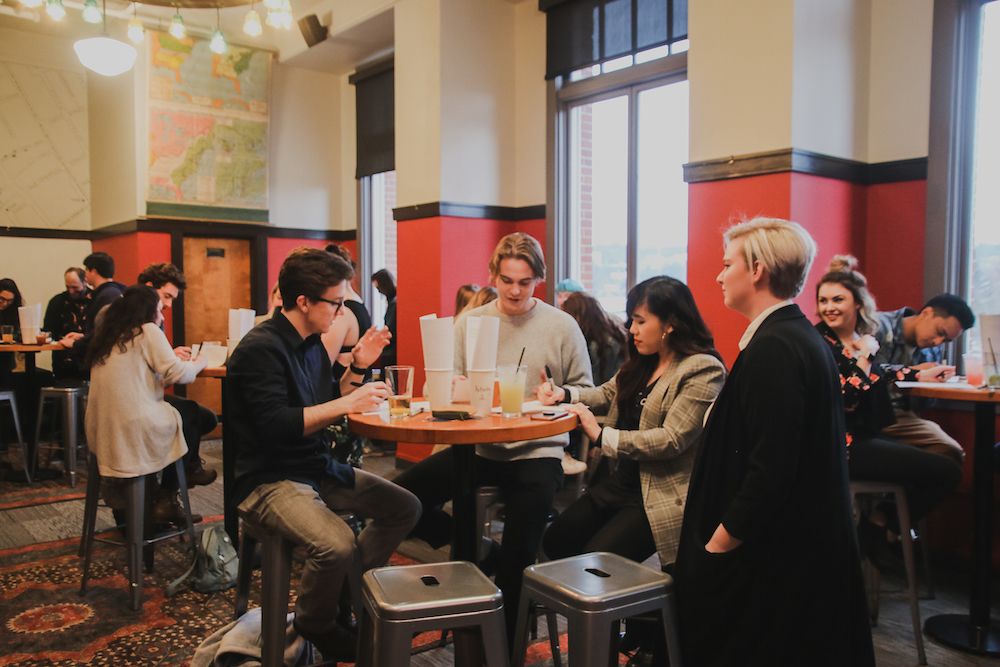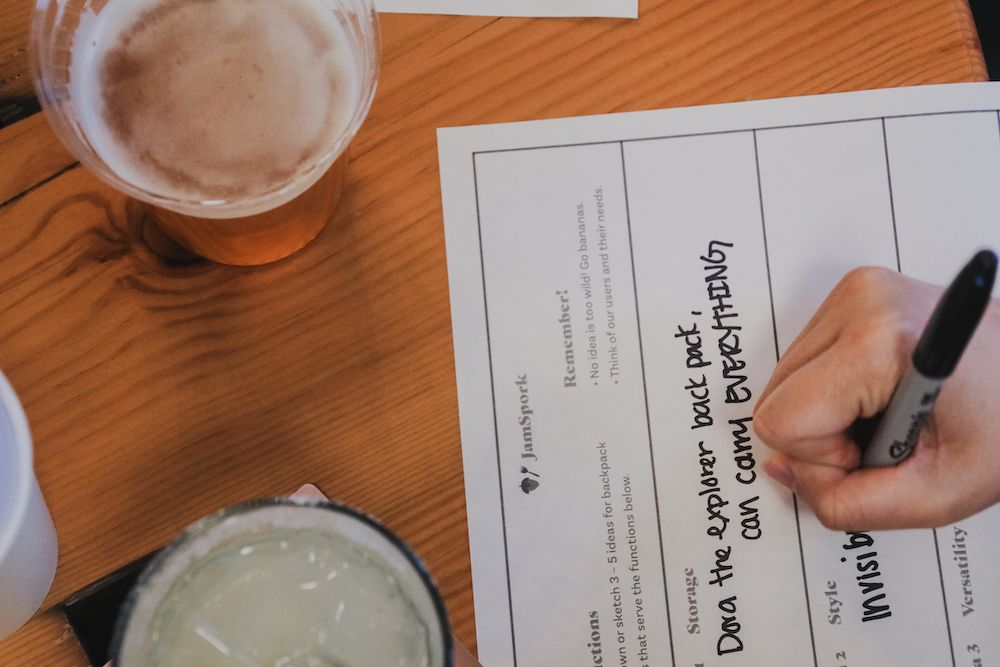Go Back
On March 15th, roboboogie’s Camp Optimization hosted Lacie Webb – our very own Sr. UX/UI Designer. This edition of our bi-monthly networking meet-up was all about Design Thinking, and the positive impact it can have on optimizing brainstorming sessions. Design Thinking is all about shifting focus to the user in order to solve problems. What does that mean? It means that listening to users’ problems and crafting empathetic, creative solutions is a surefire way to help make their lives better and easier. The best part of Design Thinking is that it’s not just for designers! Despite the name, Design Thinking is a great framework to allow people from all disciplines to take an active role in creative problem solving.

During the event, we even participated in some group-wide Design Thinking exercises that helped to get our creative juices flowing as we prototyped newer, bigger, badder backpacks for predefined users. Unable to make it to the event last week? Here are 5 key steps you can take to get started with utilizing Design Thinking in your brainstorming process.
Empathize
The first step in the process of designing effective solutions is understanding the way users think, feel, and behave. This can be accomplished in a number of ways, and Design Thinking provides a great platform to get started. Our goal here is to determine who our users are, and to understand their needs, wants, and concerns. Consider empathy-phase exercises such as user interviews or creating customer journey maps. Listening to your users creates an empathetic solution to their problems, which will be something they can more easily resonate with. By creating a foundation of who your users are, you can start problem solving and developing solutions that will be effective and achieve a deeper understanding of the issues and challenges your users are facing.
Define
Once you’ve gone through your desired process to empathize and get a better understanding of your users, it’s time to reframe and define the problem with the user in mind. Remember it’s not only our solution that needs to be empathetic, our problem needs to be empathetic too. This means it’s human-centered and allows for creative thought, but is specific enough to make the problem-solving manageable. This phase determines the direction the solution should come from and points your ideation phase in the right direction. Defining your users also helps remove any personal or professional bias there may be towards what a business thinks the real problem is.

Ideate
The Ideation phase is where we gather a group of people, ideally from different backgrounds, in order to broaden and deepen our possible solutions. For this, focus on creating as many ideas as possible and thinking outside the box to create solutions that are tailored to our users and their needs. There are literally no bad ideas in this phase. Here are some rules to live by:
- One voice at a time – Not everyone feels comfortable expressing their ideas. Avoid talking over other people in the group, and make sure to give each individual enough time and attention to fully express their idea.
- Encourage wild ideas – Don’t focus too much on technical scope or feasibility just yet. You never know which mutation of an idea will make it into the final product.
- Defer judgement – Always build on the ideas of others in a, “yes, and…” fashion and avoid saying “no.” These brainstorming sessions can be sensitive, so make an active effort to support your team.
After the ideation phase, you’ll have a large number of ideas that you’ll need to categorize and prioritize in order to determine what will go into a prototype.
Prototype
Now that we have a multitude of ideas (our exercise at the event yielded roughly 150!), we can start to prioritize and strategize around which ones we want to pursue. In this phase, we’ll take all the ideas from the ideation phase and cull them down to the top features we think our users will most resonate with.There are many ways to go about this, and Lacie mentioned two that she’s had success with in the past: affinity mapping and dot voting. Affinity mapping is grouping together similar ideas into common themes to identify patterns in the brainstorming. Dot voting allows people in the brainstorming group to vote on which ideas they think would be the best, and to see if the team is on the same page in terms of reaching a solution. The goal of the prototype phase is to create a series of quick, iterative prototypes to test with our users to gain meaningful feedback and a deeper understanding of our user base.

Test
Once you have a working prototype, it’s time to take it back to you users and – you guessed it – test it out! For physical products this could mean focus groups, and for digital products, it could be A/B testing or user interviews. Testing allows you to test your ideas with your users and gather qualitative and quantitative data in order to create feedback loops for the team to iterate and solution around. From this data, you can determine the most effective solution to the problem at hand. Testing can also give you new insights into your users and your problem, which can potentially impact your solution. Once you’ve completed this process, you may want to revisit certain stages of the process with any new insights you gained along the way. Keep in mind this process is not rigid – you can choose to reorder the stages to fit your particular problem, or repeat/eliminate certain steps depending on scope.
Putting This Process into Practice
These steps all tied in very nicely with the interactive element of the event, where we created a prototype for a better backpack. The audience was provided a business goal: Increase backpack sales for your company by 12% this quarter. Our first step to approaching this problem was to empathize with our backpack users. For this, Lacie provided some great data on how backpacks are used by the roboboogie team, and where they fall short as far as storage, features, and general usability. From there, we were able to define and reframe the problem to “Our users need a bag that is functional, versatile, and packed with special features.” Then came the fun part: ideation. We spent a few minutes jotting down ideas for how our current backpacks could be improved in terms of storage, style, versatility, technology, and WOW factor. Once we had plenty of ideas, it was time to prototype our new backpack. We worked in small groups to narrow in on our favorite ideas for the new backpack, and even sketched a prototype! All of the prototypes were wildly different, and amazing in their own ways.

From this stage, Lacie explained, we’d test our prototypes with our users, and use the test results to iterate and further improve our new product. The biggest takeaway from this event? Breaking the ice and working with others toward a creative problem solving was not only fun and memorable, but it was effective and we designed some backpacks that were way more interesting than one person alone could have envisioned.
Thank you, Lacie, for an interactive and informative event! Are you interested in embracing Design Thinking via a roboboogie-facilitated workshop? Contact us to get started.
Want to join the fun for our next Camp Optimization Event? Join us May 24th as Aaron Stusser, Ecommerce Manager at Yakima, talks about the importance of copy in making or breaking a conversion. Get a head start and RSVP today. See you there!
Written by Andrea Pappoff


